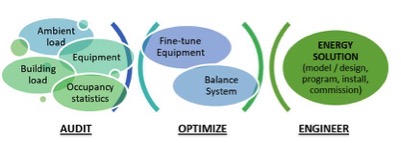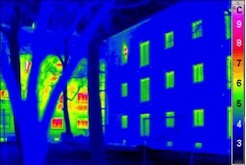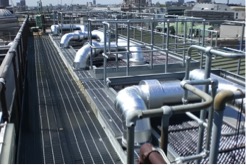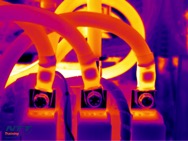Green Leaf Airconditioning Services
Energy Saving in
HVAC Chilled Water Systems
The Why’s and How’s of HVAC Energy Efficiency
The Middle East has a high ambient climatic condition (approximately 8 months of high temperatures). With 100% of all habitable space being air conditioned, the primary objective of air-conditioning in this region is for comfort cooling (temperature, humidity and fresh air intake control).
Of the two types of HVAC systems, viz., chilled water and direct expansion, the former (and most common) is used in high rises and other large cooled spaces, and the latter is mostly for villas and old low rise residential buildings. Further, the chilled water systems are either individual to each building, or district cooling systems.
It is common knowledge that buildings are the largest energy consumers globally (vs. industrial facilities, etc.)and HVAC systems consume the most energy in a building (vs. lighting, etc.), up to 70% of the building’s total energy bill, depending on climatic conditions and end-use.
Let’s consider the numbers for a typical building with chilled water systems:
- Average 600-700 TR of installed cooling capacity
- Average power consumption of 1.3 kW / TR per hour
- Usage profile of 40%
- Electricity tariff gravitating towards AED 0.45 / kWh
This translates to an approximate annual electricity bill of AED 1.3 million, for the chillers and chilled water pumps alone. There is immense, and realizable, potential for energy savings for each such building. Condensate water harvesting is another less talked about opportunity, especially given the natural paucity of water and high cost and environmental impact of desalinating sea water.
Over the last decade, as an HVAC service provider at hundreds of such buildings, we have observed some issues related to the installed equipment at site, and some pertaining to the building management budgetary issues, inefficient operating tenets, or simply a lack of awareness. As a sample:
- Gross over capacity of installed HVAC systems
- Incorrect installation and commissioning (e.g. short cycling, vibration, etc.), thereby reducing operational efficiency and increasing machine breakdowns
- Dysfunctional BMS systems
- Out-of-sync chillers, leading to erratic operational sequences and lower chiller efficiency
- Focus on equipment / sub-assembly level savings, while ignoring system level implications
- Ambitious and well-meant Energy Saving Plan implementation – but “Lost in translation”
- “Capex triumphs Opex” mindset which ignores the fact that during the lifecycle of HVAC equipment, Opex costs are 8-10 times an equipment’s first cost
- “Sustainability is a theoretical concept” – a pessimistic view deriving from inherent budgetary limitations, lack of awareness on options, or previous internal campaigns having gone sour
It is possible to practically and substantially, improve energy efficiency by a combination of corrective measures for legacy installation issues, duct and piping leakages, Demand Side Measures (DSM), and intelligent, real-time responsive electro-mechanical solutions – all without compromising on cooling comfort.

Stating the obvious as it were, let’s look at what are the main requirements from any solution offering to save energy in your HVAC system:
- No compromise on cooling – it does not help to switch off the equipment and claim savings, when the primary objective of comfort cooling is not met
- No detrimental effect on equipment lifespan – it would not be of much use to save a bit on energy at the cost of having to pay higher repair bills or quicker equipment replacement
- Budgetary constraints – “like it, want it, but cannot pay for it” is a common refrain; the solution needs to be modular, for incremental savings to match incremental solution cost
- Reliability – you don’t want a temporary fix which works great for the first year or so, only to fizzle out soon thereafter
- Convenience – and you definitely don’t want to have to baby sit the energy saving solution with manual supervision; the idea is to reduce supervision cost and increase automation to make things easy

More on HVAC energy efficiency

What are Demand Side Measures (DSM)?

HVAC Systems -
an energy profile








